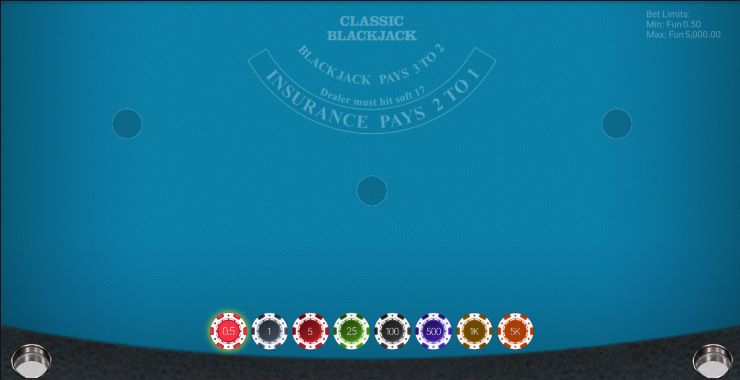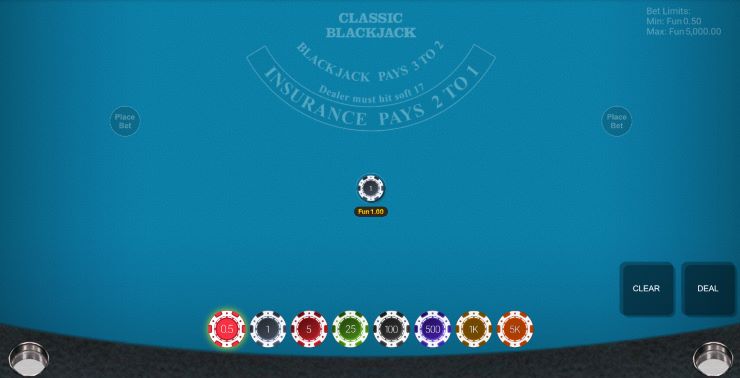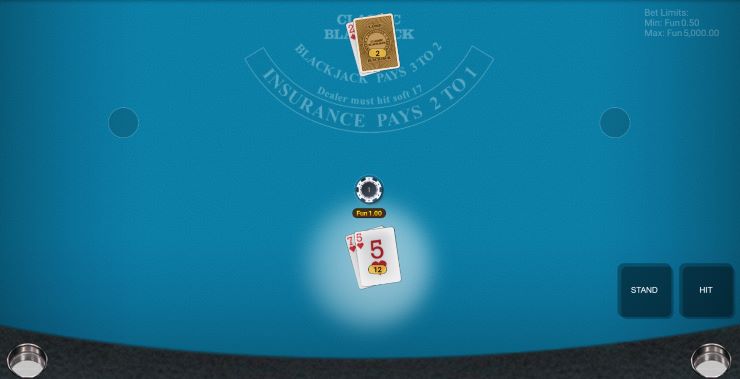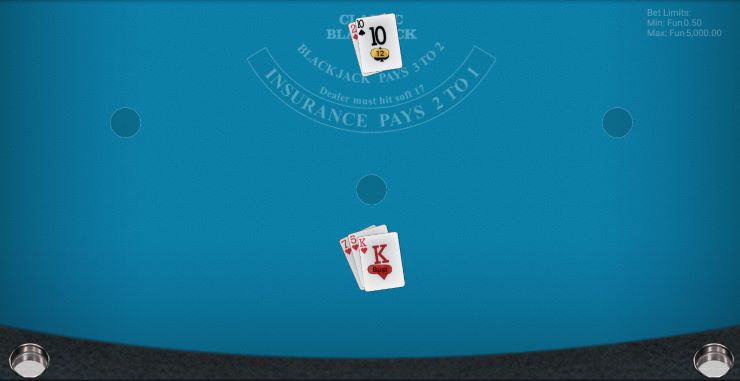Blackjack Rules for Beginners Guide 2025– How to Play Blackjack
Understanding blackjack rules, how they work and the bets that accompany them make the game more accessible and exciting to play.
Here you can also learn about how to play blackjack, the thrilling bets and side bets you can wager, and access top tips on using these rules to your advantage.
What is Blackjack?
Understanding the game and its mechanics is important for grasping the blackjack rules. Blackjack is a card game played at retail and online casinos. Players go up against the house in an attempt to get their hand value closer to 21 than the dealer’s.
We refer to blackjack as a banked card game because you play against the casino instead of other players. The premise of the game is to get your hand as close as possible to 21 without exceeding this number. If you land a hand value of 21, we call this blackjack, and you win the round. Similarly, if your hand is closer to 21 than the dealer’s, you also win the round and your bet. However, if the dealer’s hand is closer to 21, you lose the round and your bet.
The great thing about blackjack offered at the best online blackjack casinos is the game comes in multiple variations, like Perfect Pairs, 7-Card Blackjack, European Blackjack, and Pirate 21. These different versions have exciting features and several unique rules, but the basic rules for blackjack still apply to all of them.
Blackjack Rules Card Values
There are specific blackjack rules for card values. These values are essential to know and learn if you want to play a clean blackjack game. The suit and value of the cards are more important to focus on than the card colour in most instances unless you’re wagering side bets. Blackjack rules assign the following values to the cards:
- Ace—This card holds the value of 1 or 11, depending on your hand
- Jack/King/Queen (face cards)—Face cards each carry a value of 10
- Cards numbered 2-10—Numbered cards are assigned the same value as displayed on the card. For instance, an eight-of-hearts has a card value of eight points.
Rules of Blackjack for Beginners
Blackjack card game rules are simple to follow and generally easier to understand than poker or baccarat rules. The aim of blackjack is to build a hand with a value as close to 21 as possible while beating the dealer’s hand value at the same time.
Simple blackjack rules outline that the dealer must pass out the cards, two to the player and two for themselves. The dealer must place both the player’s cards face up, but only one card is placed facing upwards when dealing their own hand.
Before the croupier reveals their face-down card (hole card), the player must make their play by choosing to stand and keeping their hand as they received it or opting to hit and take an additional card. Once the player has made their move, the croupier turns over their hole card, and the totals for the player and the dealer are tallied to find the winner.
The reveal of the dealer’s hole card can lead to several possible outcomes, according to blackjack game rules. These include:
| Blackjack Outcome | What This Outcome Means |
| Blackjack/21 | Your original hand totals a value of 21, usually including an Ace and a 10. Blackjack is an outright win. |
| Higher Hand Value (than the dealer) | The value of your hand exceeds that of the dealer, placing you closer to 21. For example, your total may be 19, while the dealer’s is 17. In this case, you win the round |
| Lower Hand Value (than the dealer) | In this instance, the value of your hand is less than that of the dealer, which means you lose the round. |
| Bust | According to classic blackjack rules, when the value of your hand is more than 21, it is a bust, and you lose the round. |
| Dealer Busts | If the dealer’s hand is over the value of 21, they bust, and you win the round. |
| Push | When the value of your hand is exactly equal to that of the dealer we call it a push (tie) and your original stake is returned. |
Blackjack Rules (7 Card UK)
European or UK blackjack rules differ slightly from classic or American blackjack rules as the aim of this version of the game is somewhat different. American blackjack aims to get your hand value closer to 21 than the dealer, with each participant receiving two cards.
7 card blackjack rules outline that the game requires four players. The blackjack rules (7 card UK) also state that the dealer must provide each player with seven cards. UK blackjack aims to match your card to the card put down by the previous player. You can create a match using the card suit or value.
If the cards in your hand do not allow for a match, blackjack rules for 7 cards outline that you must pick up an additional card. The first one to discard their entire hand wins.
The basic rules of blackjack in the UK outline the following:
- Requires four players
- Each player receives a hand of seven cards from the dealer
- Dealer must set an upcard in the middle of the table
- British blackjack rules dictate you must match one of your cards to the upcard on the table
- Players can match cards using value or suit
- If a player cannot make a match, they must take another card
- To win, you must be the first to discard all the cards in your hand
- You are allowed to place a Jack on a two
- You can follow a Queen with any card of a matching suit
- If you put down an eight, the blackjack rules in the UK of 8 miss a go apply, and the player following you misses a turn.
Blackjack Rules Chart Comparing Classic and British Blackjack Variants
There are many blackjack variants available in the UK. The following table outlines key differences between what is considered to be the classic version of the game and its main UK alternative.
| Requirement | Classic/American Blackjack Rules | UK Blackjack Rules |
| Players required | 2-7 players | 4 players |
| Number of cards in an initial hand | 2 | 7 |
| Game played against | The House (dealer) | Other participants |
| Game objective | To get your hand closer to 21 than the dealer without exceeding this value | To discard all of the cards in your hand by matching them to the upcard on the table using suit or value |
| What constitutes a win | A hand value of 21 or a higher hand value than the dealer | Being the first player to get rid of all the cards in your hand |
Bets in Blackjack
Before diving into how to play blackjack, it is also vital to understand the bets you can place at the best online casinos when playing the game. Casino blackjack rules allow for several different wagers, the most popular of which include:
Stand
In the instance where your dealt hand has a high value and taking an additional card is likely to cause you to bust, you can opt to stand. To stand means to keep your hand as is and not take another card.
Hit
If your initial hand has a low value, you may choose to build your hand by requesting an additional card, known as a hit.
Double
Blackjack 21 rules allow you to double your wager and take another card if your initial hand has a hard value of 9, 10, or 11. Keep in mind, though, that once you have played this option, you cannot make any further moves.
Split
Blackjack casino rules state that if your initial hand leaves you with cards that are two of a kind (say you receive two fives), you may opt to split. However, blackjack split rules dictate that when you split, you must double your bet to cover the additional hand you now have.
Surrender
Sometimes, the rules of a blackjack card game allow for the incorporation of the surrender rule. This blackjack rule states that in the event that you receive a poor initial hand, you may opt to surrender and turn your cards in. However, forfeiting the round like this means you will only receive half of your initial stake back.
Side Bets for Blackjack
There are plenty of blackjack variations, which means there are several exciting side bets that you can wager, too. Side bets are not wagers that focus on the game’s outcome but instead, allow you to bet on happenings within the game. Blackjack betting rules allow for several side bets like:
21+3
This blackjack wager focuses on the dealer’s up card and the player’s hand. By placing a 21+3 bet, you will receive a payout should your two initial cards and the dealer’s upcard match one of these combinations:
| Combination | Description | Pays Out At |
| Flush | All three cards are from the same suit | 5:1 |
| Straight | Cards fall in consecutive numeric order (e.g. 4, 5, 6) | 10:1 |
| Straight Flush | The consecutive cards from the same suit (3♣, 4♣, 5♣) | 40:1 |
| Three-of-a-Kind | All three cards offer the same value but come from different suits (10♣, 10♠, 10♦) | 30:1 |
| Suited Triple | Three cards of the same suit and value (10♠, 10♠, 10♠) | 100:1 |
Insurance
Blackjack rules outline that an insurance bet is only applicable when the dealer’s up card is an Ace. This blackjack strategy lets you take insurance valued at half your original wager. If the dealer has an Ace and reveals their hole card to make a hand of 21, your insurance bet will cover you and payout at odds of 2:1.
Perfect Pairs
In a game of Perfect Pairs, blackjack rules allow you to wager a side bet that focuses on the player’s hand. If you receive an initial hand that results in a pair and have placed a perfect pairs bet, your original bet will pay out depending on how the pair is constructed.
| Pair Combination | Description | Pays Out At |
| Mixed Pair | Same value, different suits (5♣ + 5♥) | 5:1 |
| Coloured Pair | Same value, same colour (7♣, 7♠) | 12:1 |
| Perfect Pair | Two identical cards – same suit, colour, and value (10♣, 10♣) | 25:1 |
Important Blackjack Terms
Understanding the terms used in the rules of blackjack makes it easier to grasp the rules themselves and to know what is going on when you’re playing blackjack online. Check out the following table for the most-used blackjack terminology and its meaning.
| Blackjack Term | Description |
| 21 | A popular name for blackjack |
| Blackjack | A winning hand of two cards totalling 21 |
| Bankroll | The budget with which you can bet |
| Box | The area on the blackjack table in front of a player where they wager their bets |
| Dealer | The croupier or individual who acts on behalf of the casino by taking and paying out bets and dealing cards |
| Burn Card | The top card on the deck discarded by the croupier to prevent cheating |
| Up Card | The dealer’s face-up card |
| Hole Card | The dealer’s face-down card |
| Pair | A hand where both cards have the same value (7♣, 7♠) |
| Hard Hand | A hand that only has one value with no Ace |
| Soft Hand | A hand with an Ace that may have two values |
| Stand | To opt not to take an additional card |
| Hit | To choose to take an extra card to build your hand |
| Push | When the dealer and player’s hands equal the same value and the player’s original stake is returned to them |
| Bust | When the hand value exceeds 21 |
| Double Down | One of the rules of blackjack that allows you to place an additional wager and take another card in the instance where your original hand is a hard 9, 10, or 11. |
| Double Exposure | This version of blackjack requires the dealer to place both of their cards face-up |
| Split | Blackjack rules allow you to split your hand to create two hands, provided you double your bet, and your initial hand was a pair |
| Stand on 17 | Blackjack dealer rules state that when a dealer’s hand equals 17 or over, they may not take another card |
| Hit on 17 | Some dealer rules in blackjack require the croupier to take an additional card if their hand value equals 17 |
| Surrender | The option to surrender your hand if you feel that the cards you received are poor in return for half your original stake |
| Side Bet | A blackjack bet that focuses on aspects within the game rather than on the outcome of each round |
| Insurance Bet | A side bet that you can place if the dealer’s up card is an Ace. You win your insurance bet at odds of 2:1 if the dealer reveals their hole card to make blackjack |
| Heads Up | A blackjack game between the dealer and a single player |
| Single Deck | Blackjack games that play using only a single deck in the shoe |
| Face Cards | Cards like a jack, queen, or king |
How to Play the Game of Blackjack
Now that we have all the blackjack rules for the card game out of the way and we know what bets we can wager, let's look at how to play blackjack at an online casino:
Choose a Blackjack Game
Log in to your online casino profile and make sure you have sufficient playing funds. Check out the blackjack games on offer and pick one to play.Select Your Chip Value and Place Your Wagers
Once the game has loaded, select your chip value. Online casino chips come in several denominations ranging from £0.50 to £500, each with a unique colour. After choosing your chip value, you can place your bets. Placing your bets is simple; you only need to click the appropriate section on the blackjack table to submit your wager. Ensure that your bet value is within the table limit. Remember, you can place bets on a single hand or several by putting chips on each player block.Take Your Turn
When you’re happy with your bets, click the “Deal” icon. The dealer will then deal two cards for each hand you have bet on. They will then deal their own cards, with one face up and the other face down. Once all the cards are dealt, it is your turn to play your hand. You can choose to hit, stand, double, split, or surrender if it’s available.Wait for the Croupier to Reveal Their Hole Card
When you have played your hand, it is the dealer’s turn. They will reveal their hole card and take their turn based on its value and the blackjack rules for the dealer. They must hit if their hand value is less than 16, but if it is 17 or over, they must stand.Compare Hand Values
Now that the dealer has played their hand, you can see the outcome of that round. Blackjack rules state that if your hand has an exact value of 21 or if your hand value is higher than that of the dealer but does not exceed a value of 21, you win. Your payout here will be 1:1 unless your hand is an Ace and a ten, in which case you’ll receive odds of 2:1 or 3:2 (variant dependent). You lose your bet if the dealer’s hand is of a higher value and does not exceed 21. The outcome is a push (no winner) if your hand equals that of the dealer, and you’ll receive your original wager back
Blackjack Rules – How Odds and House Edge Work
Blackjack rules also determine external elements of the game, like house edge and game odds.
House Edge & RTP
The house edge refers to the commission the casino takes for offering the blackjack game. This commission comes out of your initial stake in the game. The rules of blackjack in the UK and globally help the casino determine the house edge and odds it applies to each game. As such, the house edge differs for each variation of the game.
You can quickly determine the house edge by looking at your chosen game’s Return-to-Player (RTP) percentage. Each game has an RTP that shows the theoretical value you should receive back from the game off a £100 bet played over time.
For example, European Blackjack has an RTP of 99.61%, which means for every £100 you wager, you should receive £99.61 back. The remainder is the house edge, which would be £0.39.
Blackjack has the lowest house edge and some of the highest RTPs, making sites with blackjack some of the highest payout casinos in the UK.
Blackjack Odds
The odds on a blackjack game make it easy to determine how much you’ll earn in payouts for a specific wager. Top UK online casinos display blackjack odds as fractional odds, where the number to the right indicates your bet value. Conversely, the number on the left shows your winnings.
For instance, if we had odds of 3:2 for a win in a blackjack game, the three indicates how much you can expect to win, and the two is your bet value. In other words, you’ll receive a £3 payout for every £2 you bet, provided your bet is successful.
Blackjack Odds and House Edge Values by Variation
The following table makes it easy to compare the house edge and odds offered on various blackjack games.
| Blackjack Variation | House Edge | RTP | Odds |
| European Blackjack | 0.39% | 99.61% | 3:2 |
| Classic/American Blackjack | 0.61% | 99.39% | 3:2 |
| Free Bet Blackjack | 1% | 99% | 3:2 |
| Online Live Blackjack | 0.49% – 0.72% | 99.51% – 99.28% | 3:2 |
| Online Electronic Blackjack | 0.50% – 2% | 99.50% – 98% | 3:2 or 1:1 |
| Face Up 21 | 0.85% | 99.15% | 1:1 |
| Switch Blackjack | 0.58% | 99.42% | 1:1 |
Simple Game Strategy for Blackjack Rules UK
Now that we have a good understanding of the simple blackjack rules, we can take a quick look at some of the best blackjack strategies. These strategic moves can be quite involved, but we cover the basic strategies below:
| Blackjack Strategy | How It Works |
| Stand on 17 or more | When you have a hard 17 (no Ace), the chances of the next card you draw having a value of less than 4 are minimal, making it better to stand. |
| Stand on 12 when the dealer has a 4, 5, or 6 | If the dealer has an upcard of 4, 5, or 6 and your hand is valued at 12, always stand. |
| Stand when you have a value of 13, 14, 15, or 16 | If the dealer’s up card has a value of 2 through 6, and your hand is valued between 13 and 16, stand. |
| Double Down when you have a hard 11 | If you get an initial hand equal to 11 but no Ace, the best option is to double down |
| Hit on an Ace and a 7 | The Ace can hold a value of 11 or 1, which means an Ace and a 7 could equal 8, making it worthwhile to hit. |
| Split Aces and 8s | Always split on Aces or eights, as these offer you a greater chance of winning one or both hands. |
| Don’t Split on 10s | If you get two 10s, you’re closer to 21 than the dealer will be (unless they land blackjack), so splitting, in this case, would be a bad move. |
Top Tips for Playing Blackjack
Playing online blackjack can be a thrilling form of entertainment. You can follow several top tips to make your online gambling experience even better and put you on the path to playing well and earning exciting payouts.
Get to Know the Blackjack Rules
Blackjack rules are the gateway to understanding the game and playing better. Getting to know these rules, how they work, and how you can use them to your advantage will help you wager more accurate bets and play a better game.
Learn Top Strategies
Blackjack strategies like standing on a hard 17 and not splitting 10s make it easier to make quick but informed decisions when it comes time to play your hand. If you know these guides well, you can boost your game and your chances of winning.
Practice Blackjack Rules with Cards Regularly
The more you practice, the better you become at the game, and the easier it is to remember the blackjack rules in the UK and the various strategies. You’ll also become more adept at placing well-informed and efficient wagers.
Visit Safe Online Casinos
Only use safe online casinos licenced and regulated by the UK Gambling Commission. These casinos must adhere to UKGC gambling stipulations, which work in favour of the player. As such, these sites all offer safe payment methods, consistent payouts, and blackjack games that are fair and un-rigged.
Practice Responsible Gambling
Lastly, but most importantly, practice responsible gambling. This may mean setting a budget to stick to, setting limits on your time at the blackjack casino, or applying for self-exclusion. If you have a gambling problem and require assistance, GamCare offers exceptional programs.
What to Avoid When Practicing Blackjack Rules
If you’re new to online blackjack, it can be easy to make mistakes. So, we have compiled a list of new players’ most common errors so you know what to avoid.
- Ignoring the Blackjack Rules—Thinking you can wing it without properly knowing the blackjack rules is a big mistake and may lead to you making poor choices that affect the outcome of your wagers.
- Splitting on 10s—If you land an initial hand of two 10s, you’re sitting pretty at 20, the closest you can get to 21 without landing blackjack. By not splitting and standing instead, you can easily win that round. Choosing to split opens you up to losses.
- Hitting When You Have a Hard 17—The odds of receiving another card with a value of less than four are not great. For this reason, it would be silly to hit on a hard 17.
- Not Implementing Side Bets—Side bets are a great way to make a little extra cash off the game; even if you don’t win the round, you still stand a chance to win your side bet.
- Forgetting to use Casino Promos—Bonuses and promotions boost your bankroll and give you extra funds to use for playing games like blackjack. This bankroll boost also makes it easier to try new strategies, explore different blackjack variations, and practice the game.
Conclusion
The rules of blackjack are straightforward, whether you’re playing American or European blackjack. Gaining a good understanding of blackjack rules, odds, betting types, and how the game works makes it easier to wager appropriate bets that are more likely to be successful.





